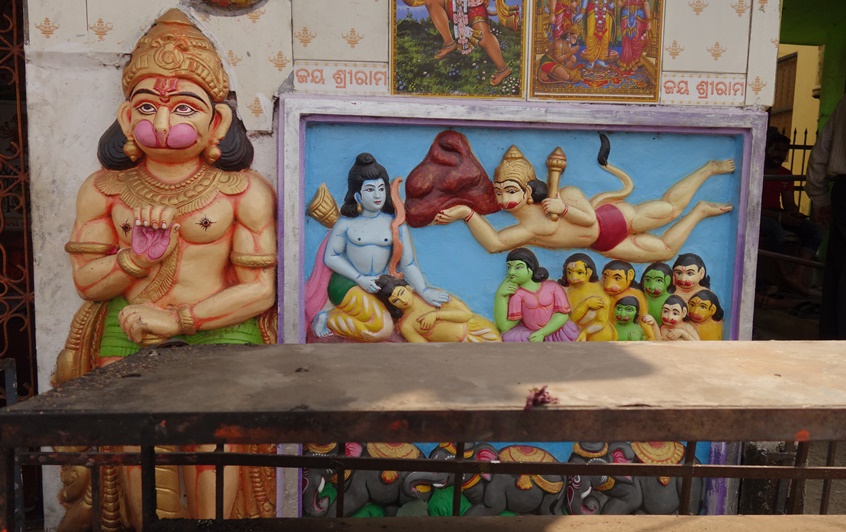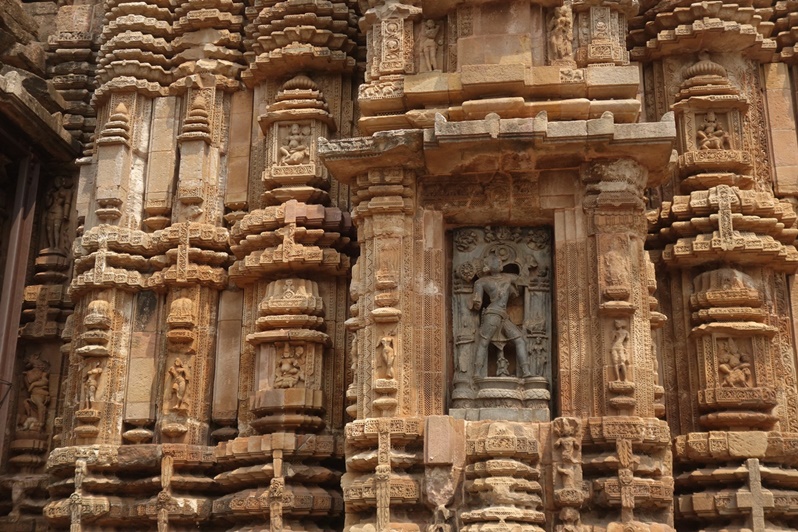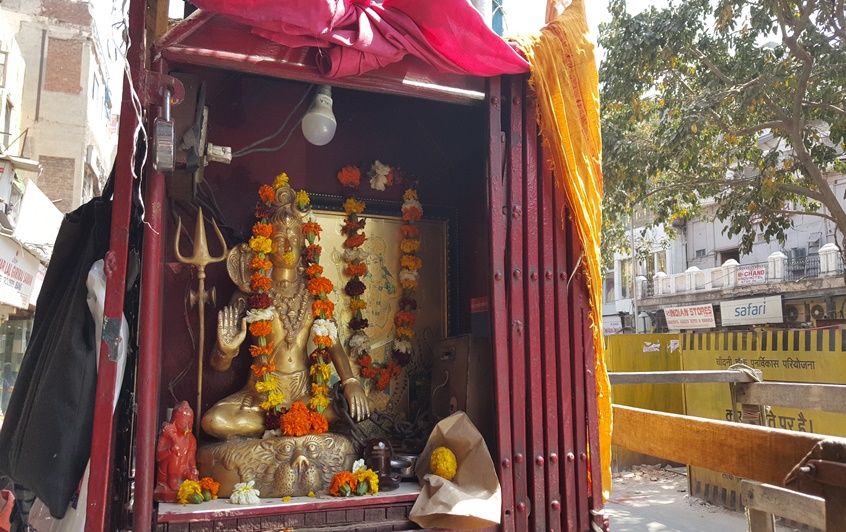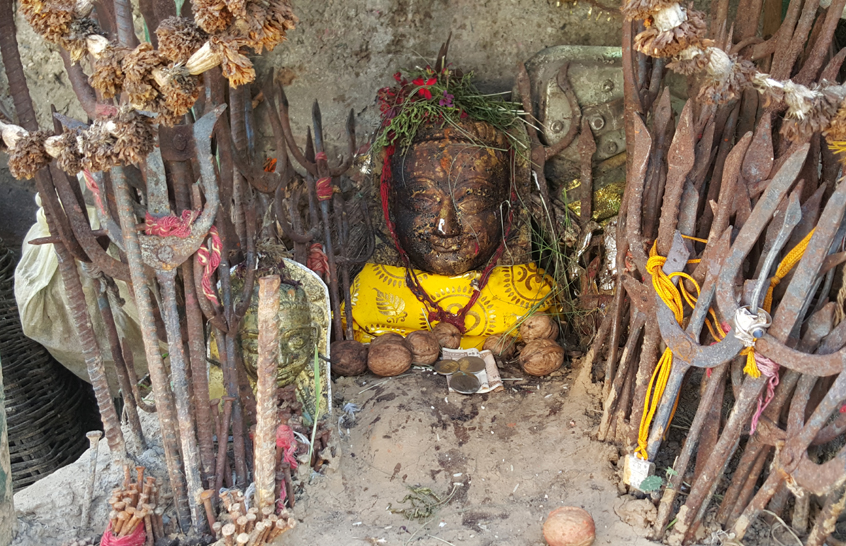
par Bertrand Bellaize, le 22 avril 2020
Art sacré hindou : clefs pour la compréhension des statues indiennes
Outre les postures et les mudras qui donnent au premier coup d’œil une signification poussée de la sculpture hindoue ou bouddhiste, de nombreux autres aspects vont nous aider à en comprendre le sens.
L’habillement et parures des statues indiennes
La divinité revêt-elle de somptueux vêtements, richement brodés ? Si cela s’avère, son aspect royal est alors mis en avant et par là même sa stature d’autorité, de capacité à guider, à protéger : Vishnou est ainsi très souvent revêtu de parures splendides qui sont là pour inspirer le respect mais aussi émerveiller, rappeler la puissance des dieux et leur statut différent des Hommes.
A l’occasion des nombreuses fêtes et rituels qui jalonnent la vie d’un hindou, les statues richement parées de tissus de toute beauté rehaussent l’aspect festif et heureux de l’évènement ; les dorures, de multiples fleurs, les nombreux plis chatoyants qui retombent en magnifique cascade, sans compter les chants, la musique souvent tonitruante, les danses de la foule en liesse créent une ambiance à la propice à la fête et au recueillement.
Par ailleurs, certaines divinités portent des couleurs distinctives, notamment : bleu pour Shiva, Krishna..., noir pour Kali, rouge pour Ganesh, rose pour Brahma ou Rama le vert et ainsi chaque couleur possède un signifiant précis :
- bleu : courage, capacité à voir et à démêler l’ignorance de la pure connaissance
- rouge : amour, énergie (couleur de la Shakti), joie
- vert : couleur des eaux primordiales d’où jaillit la vie, festivités, espérance
- rose : sagesse divine
- noir : la mort
Certaines parures sont particulièrement importantes :
- le cordon sacré (Yajnopavitâ) : dans la société hindoue, il est porté par les 3 castes principales, à savoir les brahmanes (« les prêtres »), les guerriers (Kshatryas) et les commerçants (Vaishyas). C’est un fil tressé de 3 cordons : ils représentent chacun les 3 gunas (qualités / propriétés) : de ces 3 qualités naîssent toutes choses. Rajas est l’énergie créatrice, Sattva représente l’équilibre et Tamas, la passivité, la désintégration : on retrouve ces 3 gunas dans la trimurti. Brahma symbolise Rajas, Vishnou, Sattva et Tamas, Shiva.
Ces trois qualités de l’énergie se retrouvent partout entremêlées : que ce soit au niveau le plus subtil qu’au niveau le plus grossier et ce dans des proportions variables. Parfois c’est Rajas qui domine et l’élan créatif est le plus visible, parfois c’est Sattva et l’harmonie règne ou bien c’est plutôt Tamas et alors c’est une période de destruction qui est à l’œuvre.
Le port de ce cordon fait l’objet d’un rite initiatique (upanaya) très important pour les jeunes garçons hindous : à l’issue de cette cérémonie, ils seront « deux fois nés » (la deuxième naissance étant bien entendu spirituelle).
Le cordon est toujours porté par les divinités et il s’accorde à leur tenue : si elles sont parées de parures royales, le cordon sera confectionné à partir de luxueuses étoffes, brodés de fils d’or, d’argent, ornementés de pierres précieuses …. parfois une simple guirlande de fleurs en fera office. Par contre Shiva, ascète, portera un cordon fait à partir de peau d’antilope ou bien des serpents le figureront, de même pour Ganesh. Kali quant à elle revêtira son terrible cordon de têtes de morts !
- les bustières et ceintures de part leur taille et leur emplacement peuvent aussi apporter un élément de signification supplémentaire tel que l’aspect masculin ou féminin de la divinité, des qualités de fertilité et parfois un caractère courroucé si la bustière est symbolisée par un serpent !
Les coiffures des statues indiennes
Les coiffures et couvre-chefs permettent de distinguer les figurants des divinités lors des scènes de groupes. Les divinités de second rang porteront une coiffure plus horizontale et un couvre-chef banal, type turban.
Les cheveux coiffés, lisses, tirés en chignon sont l’apanage des divinités dans leur aspect royal, doux, bienveillant, protecteur mais dès lors que les cheveux sont en broussailles (Jatabhara), en forme de flamme (Jvaleakesha), ils indiquent le divin sous sa forme énergique, combative voir courroucée : tel Durga tuant le démon buffle, Kali ou Shiva dansant ou ascète.
Kiritamukuta est la couronne portée par les dieux majeurs, haute et élancée en forme conique, elle amplifie leur nature royale et céleste leur donnant un aspect au dessus des simples mortels.
Les piédestaux des statues indiennes
L’endroit où repose la divinité possède elle aussi une symbolique forte : c’est la demeure qu’elle a choisi sur terre : elle peut être de forme arrondie ou carré voire un mélange de formes superposées.
Les formes géométriques sont un moyen habile qui a été très tôt utilisé dans la tradition védique pour assurer la transmission de l’enseignement spirituel: il est impossible de décrire l’absolu, qui par définition n’a pas de forme, pas de commencement ni de fin : seule la connaissance intérieure permet de le voir et les sages ont donc utilisé des symboles, des métaphores, des allégories pour tenter de le faire percevoir, même de façon éphémère.
Les formes géométriques yantra (en sanscrit « instrument de maîtrise ») font partie de ces moyens tentant d’exprimer le principe divin : carré, cercle et triangle sont par exemple très utilisés comme support de méditation notamment dans le Bouddhisme (mandalas). Le carré signifie la terre - le rond, l’air, la matrice - le triangle peut exprimer le principe féminin/l’eau (vers le bas) ou masculin/le feu(vers le haut). Le point représente le centre, l’origine. La combinaison de ces formes donnent l’impression de mouvement qui est l’essence même de la réalité qui ne peut être fixée ou figée.
Par ailleurs le piédestal est souvent orné de fleurs de lotus (Padmapîtha ou socle lotus), symbole de la matrice : il symbolise le sein maternel (origine de la vie), la sagesse : la connaissance qui mène à l’éveil, la pureté mais aussi la transformation (d’un milieu marécageux naît la beauté), la paix.
A travers ces différents éléments ainsi que la posture et les mudras, il est déjà possible de comprendre une grande part du message de la statue : les attributs portés par la statue ainsi que sa monture vont permettre d’avoir une vision d’ensemble.
Sources
The Book of Hindu Imagery: Gods, Manifestations and Their Meaning : Eva Rudy Janssen
Un et multiple : Sarah Combe
Mythes et dieux de l’Inde : Alain Danielou
Petite Encyclopédie des Divinités et Symboles du Bouddhisme Tibétain, Tcheuky Sèngué


